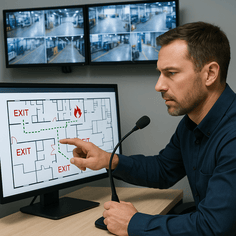
Emergency planning in a manufacturing facility is rarely simple. Between sprawling floorplans, noisy production zones, multi-lingual teams, and hazardous materials, it takes more than a laminated floor map and a fire drill to keep workers safe.
Yet one critical safety tool remains overlooked: integrating evacuation mapping with your video surveillance system.
This isn't about just adding more tech. It's about using what you already have—your cameras, your access control system, and your existing safety maps—to make evacuations smarter, faster, and more coordinated.
Let’s break down what this integration looks like, why it matters, and how it could make all the difference in a real emergency.
l
l
The Evacuation Challenge in Manufacturing Facilities
Manufacturing sites are some of the most complex environments to evacuate quickly. Here’s why:
-
Multiple buildings and access points
-
Heavy machinery and physical barriers
-
High noise levels that drown out alarms
-
Third-party contractors who may not know the layout
-
Employees spread across shifts, lines, and zones
-
Hazards like chemicals, gases, or electrical shutoffs
In an emergency, these variables slow everything down—and seconds matter.
That’s where surveillance-integrated evacuation mapping comes in.
l
l
What Is Evacuation Mapping with Video Integration?
At its core, it’s the connection of your facility’s emergency exit plan to your live camera system. Think of it as turning your static evacuation map into a dynamic, real-time decision-making tool.
Here’s how it works in practice:
-
Cameras are mapped to specific zones on your evacuation plan
-
In an emergency, you can instantly see:
-
Where people are located
-
Which exits are blocked or crowded
-
Whether routes are clear
-
Where responders should go first
-
-
Security or safety teams can guide evacuation in real-time using:
-
Live feeds
-
Intercoms
-
Mass notification tools
-
-
All footage is recorded, giving you a post-incident log for training, compliance, and liability.
l
l
Real-World Example: Why It Matters
A regional food manufacturer in Georgia experienced a small but dangerous ammonia leak in a refrigeration room. The alarm system worked—but the location of the leak forced workers to find alternate exit routes, fast.
The safety manager used their integrated surveillance and evacuation dashboard to:
-
Confirm which doors were safe to use
-
Direct teams away from the affected zone
-
Account for all shift workers within minutes
Had they relied on static maps and a walkie-talkie? The delay could have cost lives.
l
l
Key Benefits for Manufacturing Facilities
1. Faster, Smarter Emergency Response
No more guessing where the danger is or which exits are clear. You get live intel, and that saves time.
2. Improved Situational Awareness
From fire and chemical leaks to lockdowns and weather threats, you can see what’s happening across the plant in real-time—without sending someone in blind.
3. Worker Accountability and Headcounts
Camera views can help verify headcounts during mustering, especially if someone misses a check-in or doesn’t show up in the crowd.
4. Better Training and Compliance
After an evacuation, footage and system logs help evaluate how well protocols were followed. That’s gold for OSHA reviews, insurance audits, or internal improvements.
l
l
What You Need to Set It Up
If you're considering this integration, here’s what to focus on:
-
A current digital evacuation map of your facility
-
Cameras strategically placed at exits, hallways, and muster points
-
Surveillance software that allows zoning and real-time camera mapping
-
Integration with your access control and alert systems
-
Optional add-ons like voice-down systems, strobe lighting, or multilingual messaging
This isn’t a rip-and-replace upgrade. You can often build on your existing infrastructure and add strategic features for a powerful result.
l
l
Final Thoughts
Manufacturing environments demand a different level of emergency planning. Lives can be on the line, and chaos spreads fast when systems aren’t connected.
By integrating your evacuation mapping with your video surveillance system, you give your team the tools to respond instead of react. That difference is what keeps workers safe, operations resilient, and downtime minimal.
Want to see how your current surveillance and safety systems could support smarter evacuations?
Contact SSP to schedule a facility safety consultation.


